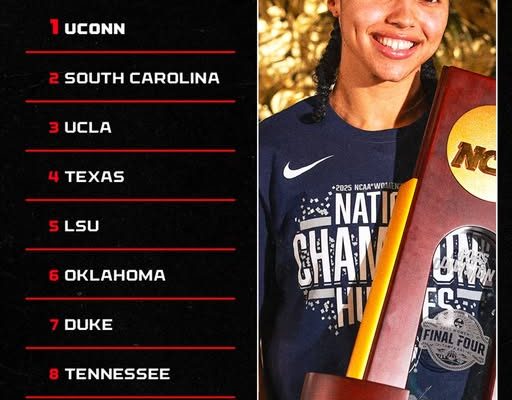The stage is set. UConn enters the 2025–26 season as the reigning champs, having captured their 12th NCAA women’s title in dominant fashion—beating South Carolina 82–59 in the final. They now sit atop the preseason AP poll, as bookmakers and analysts alike consider them one of the top favorites to win it all againBut those labels are heavy. Defending a title in women’s college basketball is no simple task.
Let’s break down why I believe a repeat is within reach, then what threatens that possibility, and ultimately whether I lean “yes” or “no.”
From the “can” side: there’s precedent, experience, and institutional strength backing UConn. This program has done it before. UConn has a tradition of national dominance, and their history includes multiple repeat titles. Their coaching legacy under Geno Auriemma gives them a blueprint. They know how to handle pressure, deep runs, scouting, Xs and Os in big games. That experience matters more than many think.
They also return key contributors. While UConn has lost players—most notably Paige Bueckers—they still retain stars like Azzi Fudd (the Final Four Most Outstanding Player) and Sarah Strong, the 2025 Freshman of the Year. Their presence gives continuity and a high floor of talent. The question is whether the supporting cast, newcomers, and role players can step up to fill gaps.
Another advantage: depth. Early reports suggest UConn has one of its deeper rosters in years, with freshmen, transfers, and bench pieces being brought in to diversify the load. (CT Insider) In a long season and in March when fatigue bites and minor injuries accumulate, a deep bench can be the difference. If UConn’s second and third units can maintain defensive energy, rebounding, hustle, and transition threat, it offsets risk.
Also, the aura and reputation matter. Opposing teams will bring their best when facing UConn. But at the same time, in tight games or hostile environments, a program used to winning, used to pressure, can find composure. That cumulative “big game toughness” is a real intangible.
Finally, look at how they closed 2025: they weren’t just lucky—UConn crushed major opponents, took down top seeds, handled pressure. In the Final Four and title game, they were dominant.That shows that when the stakes were highest, this team (with its core) could deliver. That gives them momentum and belief heading into a defense.
But make no mistake: the path to back-to-back is strewn with risks. Let me highlight the biggest headwinds.
First, losing Bueckers isn’t trivial. She was a centerpiece, a steady hand, an offensive weapon and decision-maker. Replacing her is not just a question of statistics, but of leadership, composure, and roles. Without her, there’s a vacuum to fill—especially in crunch moments. Some of that burden falls on Fudd, Strong, and new contributors. If those players can carry more load without dramatically dropping efficiency, UConn stays in the conversation.
Second, injuries & wear. Over a full season, a slight ankle, a bump, fatigue—all of these bite. If any starter gets a longer injury, or multiple bench players are unavailable in a stretch, that’s when cracks show. Deep teams can absorb losses more flexibly, but if key rotation players go down, the margin for error narrows.
Third, parity and challengers have never been stronger. South Carolina, for instance, remains elite (though they lost Chloe Kitts to an ACL tear, which is a blow). UCLA, Texas, and various emerging programs will throw up matchups, zone schemes, pressure defenses, tempo challenges. Expect more coaching chess, more scouting, more game planning to try to expose UConn’s weaknesses. No opponent will take the foot off the gas.
Fourth, single-elimination danger. A single off night in March sells a champion short. Maybe UConn has a cold shooting night, or faces a zone defense that disrupts their flow, or gets into foul trouble, or meets a matchup nightmare. In that scenario, even a “better” team can lose. Luck, bounce passes, injuries midgame—those things matter.
Fifth, mental pressure and complacency. After winning, sometimes teams subconsciously ease off or look ahead. Opponents know it: there’s a target on their back. Handling expectations, staying hungry, keeping humility—those internal things are as crucial as Xs and Os. The returning leaders must sustain intensity, guard against overconfidence, and keep the team hungry.
Sixth, bracket path & matchups. Even if UConn is strong, they might draw a brutal region, have to go through multiple top seeds early, or meet a particularly bad stylistic matchup. That makes the draw matter a lot. The fewer “trap games” and the more manageable the path, the better their odds.
So after laying out both sides: where do I lean?
I lean yes, I believe UConn can win it again. Not because it’s easy, but because all the pieces—and the odds—tilt in their favor enough that if they execute, it’s very plausible.
Let me sketch a scenario of how it might go down:
- In non-conference and early season games, UConn establishes consistency, ironclad rotations, clarity of roles, and confidence. They minimize early losses, build momentum, and test various lineups.
- The bench and rotation players grow into their roles, providing defensive stoppers, rebounding toughness, hustle, and second-wave offense.
- In conference play and the Big East, they use that stretch to work out kinks and build resilience. If they avoid collapse and get a favorable seed, that sets them up well.
- In March, they navigate through the region—perhaps avoiding multiple 1‑seeds until later—and handle the pressure. Their veteran core keeps composure in close games, defensive stops, clutch buckets.
- In the Final Four and championship, they bring the kind of dominance they showed in 2025—controlling pace, hitting shots, strong defense, and closing with authority.
If UConn strings all that together—and avoids significant injury or slippage—they absolutely have a path to back-to-back.
But it’s not guaranteed. It’s a tightrope walk. In my mind, repeating is an elite opportunity, not a safe bet. If I were to put a percentage on it, I’d say UConn’s chances might be in the ballpark of 25%–35% (maybe more, if all goes right). Not a sure thing, but among the best in the field.
Let me close by saying this: if UConn enters 2026 with hunger, accountability, depth, and no major injury, I’d bet on them in a lot of matchups. But one stumble, one off night, or one aggressive opponent could derail it. So yes—they can win it again. But they’ll be tested every step.
If you like, I can do a game-by-game projected path, pick the weakest spots, or compare their championship odds against South Carolina, UCLA, etc., for the 2026 tournament. Do you want me to run that?


